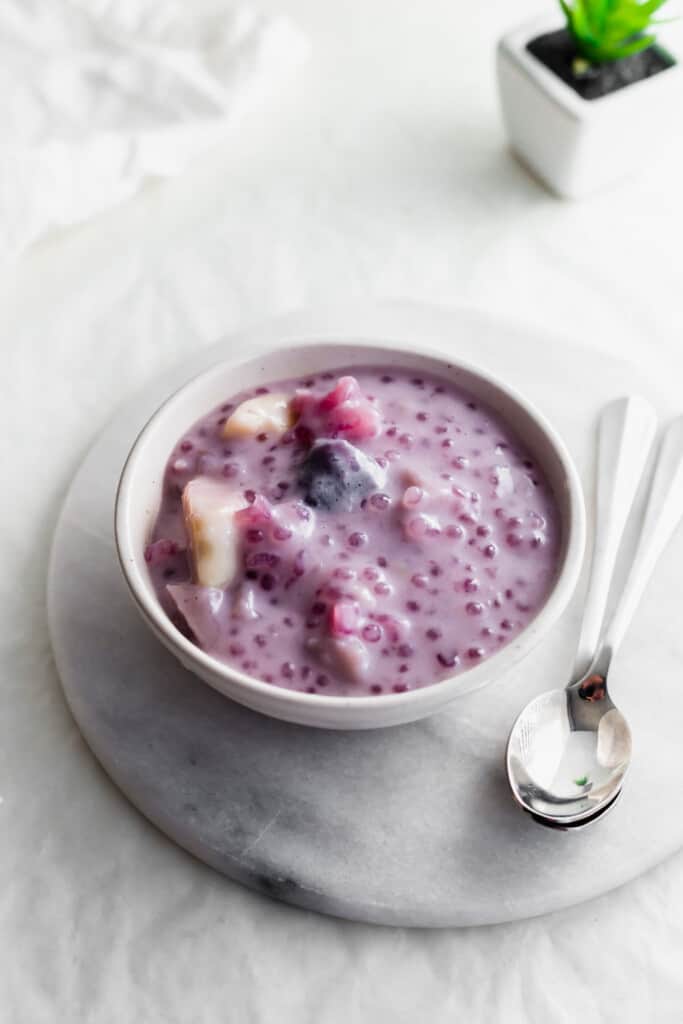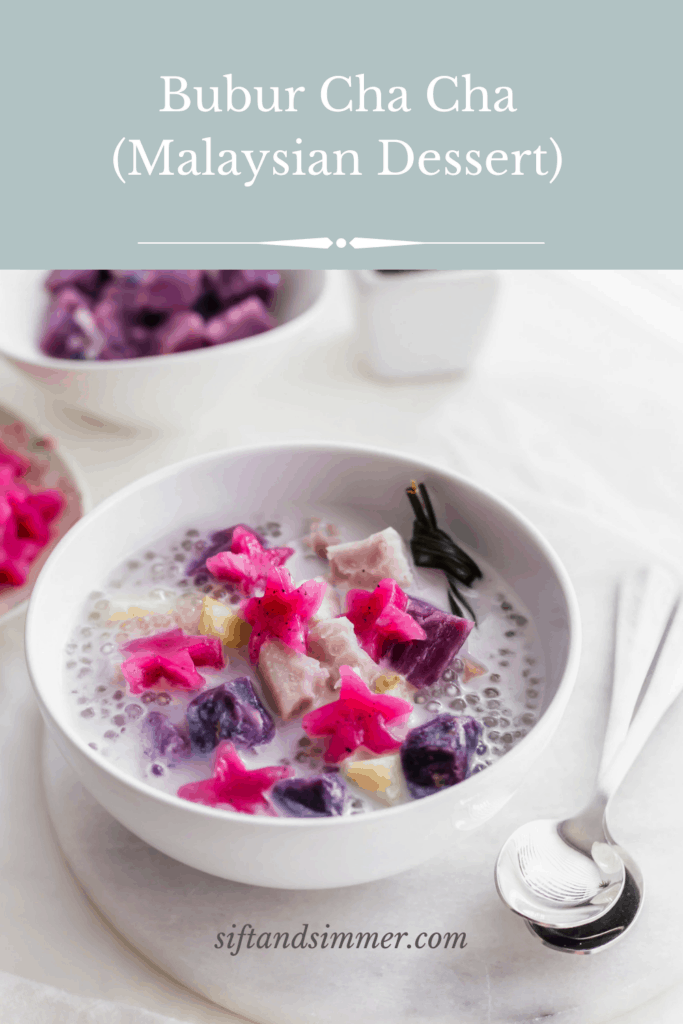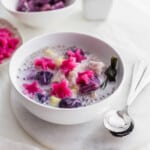Bubur Cha Cha is a Malaysian dessert which consists of coconut milk and a medley of ingredients such as sweet potato, taro and sago pearls. Pandan leaves add aroma and flavour this sweet dessert, which is enjoyed either warm or cold.
Want to save this recipe? Enter your email & I'll send it to your inbox. Plus, get great new recipes from me every week!
I love sweet, soupy desserts in the summertime.
Some of my favourites include Mango Pomelo Sago, Red Bean Soup, or Cendol.
But one of my favourite sweet soups (or "tong sui" in Cantonese) is Bubur Cha Cha.
Bubur what?
What is Bubur Cha Cha?
Bubur Cha Cha is a creamy, sweet Malaysian soup dessert originating from the Nyonya (Peranakan Chinese).
It's pronounced "bo bo cha cha" or "mo mo cha cha."
In Malay, bubur = porridge, and cha cha = well.
But, there's no consensus on what it actually means.
Some people think it eludes to a dance of sorts, and some think it refers to a mis-approximation of the Hokkien word "che che" which means prosperity.
Traditionally, Bubur Cha Cha is eaten and served to friends and family during the 15th of the Chinese New Year, but now it is commonly found all year round.
You can find it as a street food in Malaysia at any time of day.

Ingredients you'll need
Bubur cha cha contains a medley of starchy ingredients which include:
- yam (or sweet potato): any type of yam or sweet potato will work for this recipe. Personally, I love the vivid colours from purple yam, but at times, I make it with regular orange sweet potato.
- taro: is a starchy root vegetable with a brown exterior, white flesh and purple speckles on the inside. When cooked, it is similar to a potato in texture. Tip: it can cause skin irritation so if you have sensitive skin, you may want to use gloves to handle the taro.
- sago pearls: these are dried white pearls that are commonly found in Asian grocery stores. They come in various sizes, and are great in desserts, such as Mango Pomelo Sago Pudding. For this dessert, choose small sago pearls, not the large ones for bubble tea. They do not need to be soaked prior to cooking.
- tapioca jelly: like boba in bubble tea, tapioca jellies are chewy in texture. It's made with tapioca starch and water.
- palm sugar: usually comes in discs, and is less sweet than granulated sugar. If you can't find palm sugar, you can use rock sugar, coconut sugar or granulated sugar instead.
- pandan: also known as screwpine, it is a long blade-like leaf that is used as flavouring in many Southeast Asian dishes. I use it in my Kaya Coconut Jam and Kueh Dadar.
- coconut milk: I prefer to use canned coconut milk as it delivers the best flavour.
You can find most of these ingredients in Asian grocery stores.

How to make it
The easiest way to make Bubur cha cha is to cook all of the components separately and then bring them together into the coconut milk.
I find this is the best way to preserve the texture of each ingredient.
Otherwise, you have overcooked, mushy yams, and undercooked tapioca jellies.
How to make tapioca jellies
For the tapioca jellies, you can make these at home using 2 ingredients:
- tapioca starch
- hot water
Similar to my recipe for Homemade Bubble Tea Tapioca Pearls (Boba), you just mix hot boiling water into the tapioca starch and mix together to form a dough.
Note: It's important that the ratio of water to tapioca starch is right; otherwise you will end up with a gummy mess.
Add the water in a little at a time until it reaches a "playdough" consistency.
If you want to make the jellies colourful, you can add food colouring of your choice (I used pink pitaya natural food powder) to make them pink.
To make the star jellies, I rolled out the dough using a rolling pin and used a small cookie cutter to cut out star shapes.
How to cook sago pearls
Sago pearls and tapioca jellies provide chewy texture in this soup. White sago pearls come in different sizes.
For this dessert, we're using small sago pearls (not the medium or large sized ones for bubble tea). You can pick up packages of sago pearls at Asian supermarkets.
To cook the sago pearls, add the water into the pot, bring it to a boil, and then dump the sago pearls in. Give it a stir.
Remove it from the heat, and intermittently stir the sago pearls from time to time. It may seem strange to cook the pearls this way, but this is an optimum way to obtain perfect chewy texture in the sago.
Once the sago pearls turn translucent, they're ready to use.
Tip: it's perfectly fine if there's still a bit of white opaqueness in the centre.
Putting it together
To make the pandan coconut milk, add water to a large pot and bring it a boil. Add in the palm sugar and stir until it's dissolved.
Tie the pandan leaves into a knot and place into the pot. Add in the coconut milk and stir together.
Add the cooked yam, taro, tapioca jellies and sago into the coconut milk and heat until just warmed.
Variations and substitutions
Each region has its own version of Bubur Cha Cha.
Other iterations may incorporate:
- banana
- black eyed peas
- colourful tapioca jellies
- yam instead of sweet potato
- pumpkin
If you don't like coconut milk, you can try a dairy-free oat or almond milk.
How to serve & store
You can serve Bubur Cha Cha either hot or cold.
Note: The mixture may solidify when it's cool, due to the presence of coconut milk.
You can store Bubur Cha Cha in an airtight container for up to 5 days in the fridge.
If you plan on eating it warm, heat it up in a saucepan. You may need to additional coconut milk to loosen it, as the jellies will have congealed.
You can also microwave it for 30 seconds if enjoying it warm.
FAQ's
Can you freeze it?
No, it's not suitable for freezing.
Do I need to add colours to the jellies?
No, they're purely optional.
Where can I find pandan leaf?
You can find pandan leaf at Asian grocery stores; sometimes in the freezer section.
Other Malaysian recipes you may like
Kolo Mee (Sarawak Malaysian Noodles)
Mini Kueh Dadar (Rolled Coconut Crepes)
Bubur Cha Cha is vegan, gluten-free, and can be a hearty, nutritious and nourishing dessert.
Cold or hot, try out this recipe and see why it's one of my childhood favourites.
Have you had this Malaysian Chinese dessert before? Let me know if you try out my recipe -- tag me on Instagram @siftandsimmer or leave me a comment/rating below!


Bubur Cha Cha
For accuracy and precision in baking recipes, use weight (metric) measurements when available.
Ingredients
- 1 large taro root peeled and diced
- 1 medium yellow yam peeled and diced
- 1 medium purple yam peeled and diced
- 3 C water
- 2-3 discs palm sugar (sweeten to taste)
- 3-4 pandan leaves knotted
- 1 ½ cans coconut milk
Pink Tapioca Jellies:
- 50 g tapioca starch
- ¼ C hot boiled water
- 8 g pink pitaya powder
Sago Pearls:
- ½ C dried sago pearls
- 1 C water
Instructions
Boil the taro and yam:
- Fill a large pot with water and bring to a boil. Add in the diced taro and yam. Boil until taro and yam have softened, about 10-15 minutes. Drain into a colander and set aside.
Make the tapioca jellies:
- Next, make the tapioca jellies. Put the tapioca starch and pink pitaya powder into a medium bowl and add in the hot boiling water. Use a spatula to mix until a dough forms. If the dough feels too dry, add in a little water at a time. The consistency should feel like playdough.
- Use your hands to knead the dough and transfer it onto a flat surface. Roll into a long coil and cut into desired shape. Or flatten with a rolling pin and use a small cookie cutter to cut out shapes (like I did with the stars). Dust with additional tapioca starch if it's too sticky.
- Fill a small pot with water and bring to a boil. Add in the tapioca jellies and cook for about 6-7 minutes, until they float to the top. Strain out the jellies and set aside in a clean bowl.
Cook the sago pearls:
- Using a small pot, add in the 1 C water and bring to a boil.
- Pour in the sago pearls, give it a quick stir and turn off the heat. Remove the pot from heat and replace the lid. Give it a stir every so often. The sago pearls will be cooked when they're translucent, about 20-30 minutes.
Assemble:
- In a large pot, add the 3 C of water and the palm sugar discs. Bring to a boil and stir to dissolve the sugar.
- Tie the pandan leaves into a knot and throw them into the pot. When the sugar has completely dissolved, bring the heat down to a simmer and stir in the coconut milk. Remove the pandan leaves.
- Next, gently add the cooked taro, yam, tapioca jellies, and sago pearls into the coconut milk. When the mixture is warmed through, turn off the heat and serve.
- Serve bubur cha cha warm or chilled.
Nutrition
The nutritional information provided should be considered as approximate and is not guaranteed. Please use your best judgment to ensure food is safely prepared and/or a good fit for your diet.
This article was originally published for Curious Cuisiniere.








Yumi
So colourful, amazing as always! :), cannot wait to try this!
Michelle
Awesome, thanks Yumi!
Ellyna Eng
Hi,
Please confirm if the sago pearls needed pre soaking prior to boiling.
Thank you
Michelle
No, they don't need to be pre-soaked.
Beth Sachs
I've never had a sweet soup before but this looks so delicious. One to make soon!
Michelle
Thanks Beth, hope you enjoy it!
Biana
I have never made this before, and it sounds simple to make. Looking forward to making this yummy dessert!
Toni
I can't tell you how excited I was to find your recipe! I used to live in Singapore and friends took me to a tiny back alley shop where all they made was Bubur cha cha. I'll never forget it. It was such a joy to make it at home. Brought back many delicious memories.
Michelle
Ahh, super happy to hear it! 🙂 Thanks Toni!
Ashley
The colors are amazing, and I can't wait for summer to come in season so I can try this! Yum!
Emily Liao
This was my first time having a dessert like this. So delicious and loved the coconut flavors.
Michelle
Glad to hear that you enjoyed it, Emily!
Linsey
I always like to eat Bubur Cha Cha during my childhood. This recipe bring back the fun memory of eating. Will gather all the ingredients to make this soon. Thanks!
Mar
This Bubur Cha Cha is a great dessert for all of my visitors. They are drawn in not just by the stunning appearance but also by the irresistible flavor of the dessert!